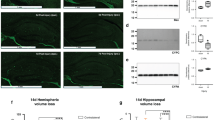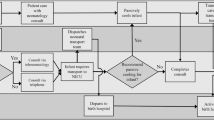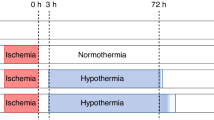Abstract
Fundamental questions remain about the optimal temperature, duration, and mode of delivery that provide the best striatal neuroprotection from hypothermia after perinatal hypoxia-ischemia. This study used stereological methods to investigate whether a mild (i.e. 2°C) or a moderate (5°C) decrease in whole body temperature, for 6 h immediately postinsult, was neuroprotective for striatal medium-spiny neurons after perinatal hypoxia-ischemia in the rat. This study also investigated whether moderate hypothermia had any effect on normal striatal development. Hypoxia-ischemia or sham hypoxia-ischemia was induced on postnatal day (PN) 7. Pups were kept either normothermic, mildly hypothermic, or moderately hypothermic for 6 h immediately postinsult. The absolute number of striatal medium-spiny neurons was calculated using modern stereological methods. There was no significant difference in the absolute number of medium-spiny neurons in the right striatum after either mild hypothermia or moderate hypothermia. There was also no significant difference in the absolute number of medium-spiny neurons between the control normothermic and the control moderately hypothermic pups. The latter results suggest that moderate hypothermia for 6 h immediately postinsult may be a safe treatment for striatal medium-spiny neurons. Yet, neither mild nor moderate hypothermia alone for 6 h immediately posthypoxia-ischemia is neuroprotective for striatal medium-spiny neurons.
Similar content being viewed by others
Log in or create a free account to read this content
Gain free access to this article, as well as selected content from this journal and more on nature.com
or
Abbreviations
- CE:
-
coefficient of error
- H/I:
-
hypoxic/ischemic
- N:
-
total (i.e. absolute) number of neurons
- NV:
-
neuronal density
- PN7:
-
postnatal day 7
- PN14:
-
postnatal day 14
- Vref:
-
total reference volume
References
Berger R, Garnier Y 1999 Pathophysiology of perinatal brain damage. Brain Res Brain Res Rev 30: 107–134
Eicher DJ, Wagner CL, Katikaneni LP, Hulsey TC, Bass WT, Kaufman DA, Horgan MJ, Languani S, Bhatia JJ, Givelichian LM, Sankaran K, Yager JY 2005 Moderate hypothermia in neonatal encephalopathy: efficacy outcomes. Pediatr Neurol 32: 11–17
Shankaran S, Laptook AR, Ehrenkranz RA, Tyson JE, McDonald SA, Donovan EF, Fanaroff AA, Poole WK, Wright LL, Higgins RD, Finer NN, Waldemar AC, Duara S, Oh W, Cotten CM, Stevenson DK, Stoll BJ, Lemons JA, Guillet R, Jobe AH 2005 Whole body hypothermia for neonates with hypoxic-ischemic encephalopathy. N Engl J Med 353: 1574–1584
O'Brien FE, Iwata O, Thornton JS, De Vita E, Sellwood MW, Iwata S, Sakata YS, Charman S, Ordridge R, Cady EB, Wyatt JS, Robertson NJ 2006 Delayed whole-body cooling to 33 or 35°C and the development of impaired energy generation consequential to transient cerebral hypoxia-ischemia in the newborn piglet. Pediatrics 117: 1549–1559
Trescher WH, Ishiwa S, Johnston MV 1997 Brief post-hypoxic-ischemic hypothermia markedly delays neonatal brain injury. Brain Dev 19: 326–338
Thoresen M, Bagenholm R, Loberg EM, Apricena F, Kjellmer I 1996 Posthypoxic cooling of neonatal rats provides protection against brain injury. Arch Dis Child Fetal Neonatal Ed 74: F3–F9
Bona E, Hagberg H, Loberg EM, Bagenholm R, Thoresen M 1998 Protective effects of moderate hypothermia after neonatal hypoxia-ischemia: short- and long-term outcome. Pediatr Res 43: 738–745
Rice JE, Vannucci RC, Brierley JB 1981 The influence of immaturity on hypoxic-ischemic brain damage in the rat. Ann Neurol 9: 131–141
Galvin KA, Oorschot DE 1998 Postinjury magnesium sulfate treatment is not markedly neuroprotective for striatal medium spiny neurons after perinatal hypoxia/ischemia in the rat. Pediatr Res 44: 740–745
Volpe JJ 1992 Perinatal hypoxic-ischemic brain injury: overview. In: Fukuyama Y, Suzuki Y, Kamoshita S, Casaer P (eds) Fetal and Perinatal Neurology. Karger, Tokyo, pp 232–252
Covey MV, Murphy MP, Hobbs CE, Smith RA, Oorschot DE 2006 Effect of the mitochondrial antioxidant, Mito Vitamin E, on hypoxic-ischemic striatal injury in neonatal rats: a dose-response and stereological study. Exp Neurol 199: 513–519
Galvin KA, Oorschot DE 2003 Continuous low-dose treatment with brain-derived neurotrophic factor or neurotrophin-3 protects striatal medium spiny neurons from mild neonatal hypoxia/ischemia: a stereological study. Neuroscience 118: 1023–1032
Laptook AR, Corbett RJ, Sterett R, Garcia D, Tollefsbol G 1995 Quantitative relationship between brain temperature and energy utilization rate measured in vivo using 31P and 1H magnetic resonance spectroscopy. Pediatr Res 38: 919–925
Laptook AR, Shalak L, Corbett RJ 2001 Differences in brain temperature and cerebral blood flow during selective head versus whole-body cooling. Pediatrics 108: 1103–1110
Cochran WG, Cox GM 1992 Experimental Designs. John Wiley & Sons, New York, pp. 17–23
Oorschot DE Total number of neurons in the neostriatal, pallidal, subthalamic, and substantia nigral nuclei of the rat basal ganglia: a stereological study using the Cavalieri and optical disector methods. J Comp Neurol 366:580-599 Erratum: 1998 J Comp N. eurol 396: 556
Gundersen HJ, Jensen EB 1987 The efficiency of systematic sampling in stereology and its prediction. J Microsc 147: 229–263
Gundersen HJ 1986 Stereology of arbitrary particles. A review of unbiased number and size estimators and the presentation of some new ones, in memory of William R. Thompson. J Microsc 143: 3–45
Gundersen HJ, Jensen EB, Kieu K, Nielsen J 1999 The efficiency of systematic sampling in stereology-reconsidered. J Microsc 193: 199–211
Thoresen M, Satas S, Loberg EM, Whitelaw A, Acolet D, Lindgren C, Penrice J, Robertson N, Haug E, Steen PA 2001 Twenty-four hours of mild hypothermia in unsedated newborn pigs starting after a severe global hypoxic-ischemic insult is not neuroprotective. Pediatr Res 50: 405–411
Ma D, Hossain M, Chow A, Arshad M, Battson RM, Sanders RD, Mehmet H, Edwards AD, Franks NP, Maze M 2005 Xenon and hypothermia combine to provide neuroprotection from neonatal asphyxia. Ann Neurol 58: 182–193
Zhu C, Wang X, Cheng X, Qiu L, Xu F, Simbruner G, Blomgren K 2004 Post-ischemic hypothermia-induced tissue protection and diminished apoptosis after neonatal cerebral hypoxia-ischemia. Brain Res 996: 67–75
Yang X-F, Kennedy BR, Lomber SG, Schmidt RE, Rothman SM 2006 Cooling produces minimal neuropathology in neocortex and hippocampus. Neurobiol Dis 23: 637–643
Busto R, Dietrich WD, Globus MY, Valdes I, Scheinberg P, Ginsberg MD 1987 Small differences in intraischemic brain temperature critically determine the extent of ischemic neuronal injury. J Cereb Blood Flow Metab 7: 729–738
Rogalska J, Caputa M, Wentowska K, Nowakowska A 2004 Stress-induced behaviour in juvenile rats: effects of neonatal asphyxia, body temperature and chelation of iron. Behav Brain Res 154: 321–329
Mishima K, Ikeda T, Yoshikawa T, Aoo N, Egashira N, Xia YX, Ikenoue T, Iwasaki K, Fujiwara M 2004 Effects of hypothermia and hyperthermia on attentional and spatial learning deficits following neonatal hypoxia-ischemic insult in rats. Behav Brain Res 151: 209–217
Nedelcu J, Klein MA, Aguzzi A, Martin E 2000 Resuscitative hypothermia protects the neonatal rat brain from hypoxic-ischemic injury. Brain Pathol 10: 61–71
Wagner BP, Nedelcu J, Martin E 2002 Delayed postischemic hypothermia improves long-term behavioral outcome after cerebral hypoxia-ischemia in neonatal rats. Pediatr Res 51: 354–360
Tomimatsu T, Fukuda H, Endoh M, Mu J, Kanagawa T, Hosono T, Kanzaki T, Doi K, Kubo T, Murata Y 2003 Long-term neuroprotective effects of hypothermia on neonatal hypoxic-ischemic brain injury in rats, assessed by auditory brainstem response. Pediatr Res 53: 57–61
Hobbs C, Oorschot D 2004 Long-term rescue of striatal neurons and motor skills by combined antioxidant-hypothermia treatment after neonatal hypoxic-ischemic brain injury in the rat. N Z Med J 117: 3. Retrieved from http://www.nzma.org.nz/journal/117-1202/1086/content.pdf. Accessed on January 16 2007.
Author information
Authors and Affiliations
Corresponding author
Additional information
Supported by the University of Otago in the form of a PhD Postgraduate Scholarship to MVC.
Rights and permissions
About this article
Cite this article
Covey, M., Oorschot, D. Effect of Hypothermic Post-Treatment on Hypoxic-Ischemic Striatal Injury, and Normal Striatal Development, in Neonatal Rats: A Stereological Study. Pediatr Res 62, 646–651 (2007). https://doi.org/10.1203/PDR.0b013e318157d1fe
Received:
Accepted:
Issue date:
DOI: https://doi.org/10.1203/PDR.0b013e318157d1fe
This article is cited by
-
Hypothermia combined with extracellular vesicles from clonally expanded immortalized mesenchymal stromal cells improves neurodevelopmental impairment in neonatal hypoxic-ischemic brain injury
Journal of Neuroinflammation (2023)
-
Treatment temperature and insult severity influence the neuroprotective effects of therapeutic hypothermia
Scientific Reports (2016)
-
Effects of combination therapy using hypothermia and erythropoietin in a rat model of neonatal hypoxia–ischemia
Pediatric Research (2013)



